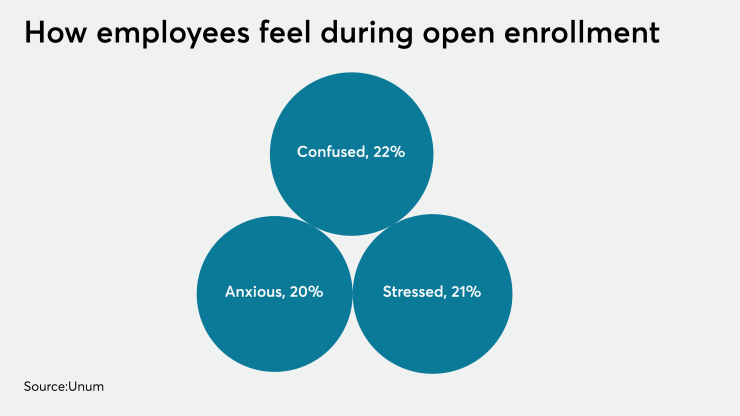Employers are satisfied overall with the effectiveness of their open enrollment communication strategies, but there are still obstacles to be overcome, particularly during the preparation phase, according to Employee Benefit Adviser’s Open Enrollment Readiness Benchmark (OERB) survey, sponsored by ADP. In addition to assessing employers’ level of readiness, the quarterly OERB survey asks employers about key issues they face during open enrollment (plan design, prep, management and analysis) to help benefit advisers understand how they can better assist their employer clients with managing the open enrollment benefits process.
Communications are effective, but still pose challenges during open enrollment preparation phase. Perhaps the biggest concern for companies is ensuring that they are communicating with their employees in the most effective way during the open enrollment prep phase.
“The challenge for us is to determine the best method for communicating,” says one employer. “And how best to reach our entire employee base.”
Not surprisingly in today’s digital world, the most popular communication channel by far is email (see Figure 1). 89% of employers use email to communicate with their employees, while 66% use an online portal. The personal touch is still valued, however, with in-person group sessions (60%) and in-person one-on-ones (48%) also registering high scores.
Employers consider their methods to be working – more than 97% believe their communication strategies are somewhat, very or extremely effective (see Figure 2). Some of the reasons HR professionals cite for this success include: keeping things simple; clear communications and transparency with costs; early and frequent communication; and being available in person to discuss employee concerns. The results of these communication efforts can be seen in the level of understanding among their employees. On a scale of 1 to 10 from “no understanding” to a “high level of understanding,” the vast majority of employees scored 6 or higher (see Figure 3).
Phase 1
Benefit Plan Design
Phase 1
Benefit Plan Design
Phase 2
Open Enrollment Preparation
Phase 2
Open Enrollment Preparation
Phase 3
Open Enrollment Management
Phase 3
Open Enrollment Management
Phase 4
Open Enrollment Design Analysis & Follow-Up
Phase 4
Open Enrollment Design Analysis & Follow-Up
Clearly, communication is a vital component of open enrollment and an area where brokers can add significant value by helping employers get key benefits information into employees’ hands. Understandably, employers are sticking with what’s been tried and tested, and for the
most part are making few changes to their communication methods (see Figure 1). Note, however, the use of text messaging and mobile applications is set to nearly double in the upcoming enrollment period.
But improvements can always be made. During the open enrollment preparation phase in particular, there are many challenges. This is reflected in the low readiness score of 22 (as of Q2 2019) for planning/designing communications for employers with a Q1 2020 benefit start date (see Figure 4).
Respondents to the survey articulate the issues and certain patterns clearly emerge. “Explaining a lot of detailed information knowing there is a very short attention span for employees,” is one common theme.
“Making sure communications are clear enough to understand,” is another. Other major challenges include “Reaching employees who don’t have email access” and “Waiting for renewals/final plan designs/final board approval in order to finalize communications.”
Brokers should plan to address these issues in working with their clients. Respondents also offer insights on what would be beneficial to their employees to help them prepare for open enrollment. “A Benefits 101 would likely be helpful – basics of terms and designs and how they impact the cost of the plans,” suggests one employer. Other common themes include: benefits education throughout the year, not just during open enrollment; detailed open enrollment meetings explaining all benefits; communication of plan changes; and getting the employees to look at the information rather than assume they know it. Brokers have an opportunity to show their value by helping their clients provide the education their employees need.
Overall, open enrollment readiness scores (as of Q2 2019) for employers with a Q1 benefit start date have a composite score of 51 (see Figure 4). As the Q2 2019 focus shifts toward open enrollment preparation, this phase’s composite score of 47 reflects a satisfactory state of readiness for this time of the year. On an individual level for this phase, a high score for enrollment timing (71) is very encouraging, with solid scores for setting goals (51) and reviewing compliance/eligibility issues (48).
However, a low score of only 22 for planning/designing employee communications should cause concern. One employer explains, “All the benefit plans have not been finalized yet. We’re waitingon that part before we craft our communication strategy,” while another notes the need to “determine the best method for communicating and how to reach our entire employee base.” A common reason for delay is “creating materials that are detailed but concise enough so that employees will read them.” In short, the challenge, as one employer says is “making it fresh and engaging.”
The phase scores for benefit plan design (69), management (30) and program analysis (57) point to the process moving forward and being comfortably on track. As Steve Rosenthal, CEO & President, Triton Benefits & HR Solutions, observes, “If we can get ID cards in employee hands around the end of year holidays, we’ve done a good job.”
To arrive at these scores, the OERB tracks 20 open enrollment activities and asks employers to submit self-assessments of the progress they have made in each. Responses range from no progress, which equates to a score of 0, to completed, which equates to a score of 100.
For more information and additional content, please click

